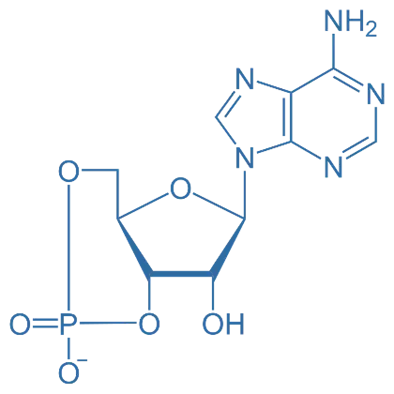- Cyclic adenosine monophosphate (cAMP) is a crucial second messenger in cellular signaling, mediating extracellular signals to initiate specific intracellular responses.
- Cyclic Adenosine Monophosphate (cAMP) plays a key role in various physiological processes, including metabolism, gene regulation, and neuronal function.

Structure of Cyclic Adenosine Monophosphate (cAMP)
- cAMP is synthesized from ATP and consists of:
-
Adenine Base:
- A nitrogen-containing compound forming part of the nucleotide.
-
Ribose Sugar:
- A five-carbon sugar forming the molecular backbone.
-
Single Phosphate Group:
- Forms a cyclic bond with the ribose sugar, connecting to both the 3′ and 5′ carbons.
- This cyclic structure differentiates cAMP from linear nucleotides and facilitates its unique role in cellular signaling.
-
Production and Function of cAMP
-
Synthesis:
- Produced by adenylate cyclase, an enzyme activated by cell surface receptors such as G protein-coupled receptors (GPCRs) in response to external signals (e.g., hormones, neurotransmitters).
- Reaction: ATP → cAMP + PPi
-
Functions:
-
Signal Transduction:
- Acts as a second messenger, relaying extracellular signals to intracellular targets.
-
Activation of Protein Kinase A (PKA):
- Binds to and activates PKA, which phosphorylates various proteins, influencing cellular processes like metabolism, gene expression, and cell signaling.
-
Advertisements
Biological Significance of cAMP
-
Signal Transduction:
- Amplifies and mediates cellular responses to external stimuli, ensuring effective intracellular communication.
-
Regulation of Gene Expression:
- Activates transcription factors like CREB (cAMP response element-binding protein) to regulate gene expression.
-
Metabolic Control:
- Regulates pathways such as glycogen breakdown and lipolysis, adjusting cellular metabolism based on external conditions.
-
Cell Growth and Differentiation:
- Modulates signaling pathways influencing cell growth, differentiation, and function.
-
Neuronal Function:
- Regulates synaptic plasticity and neuronal excitability, playing a role in learning and memory.
Termination of cAMP Signaling
-
Degradation by Phosphodiesterases (PDEs):
- cAMP is broken down into AMP by phosphodiesterases (PDEs) to terminate its signaling effects.
- This ensures that cAMP-mediated signals are specific, transient, and regulated according to the cell’s needs.
- cAMP’s role as a second messenger highlights its importance in cellular communication, metabolic regulation, and physiological responses.
